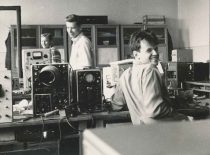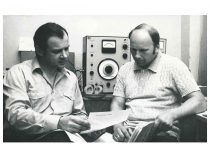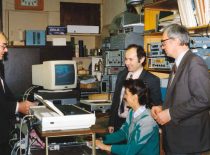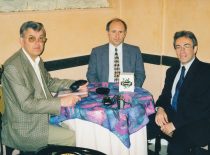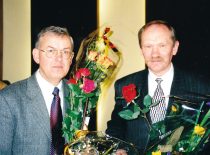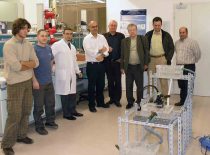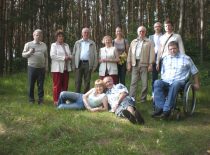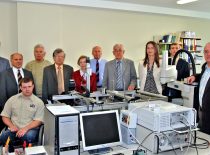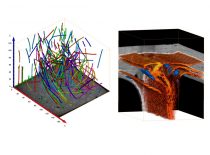Establishment of the ultrasound laboratory at Kaunas Polytechnical Institute
11 February 2020 marks 60 years from the establishment of Prof. K. Baršauskas Ultrasound Research Institute. Its origins go back to the independent Ultrasound Laboratory established at the initiative of the Rector of Kaunas Polytechnical Institute prof. K. Baršauskas; its first head was doc. Enrikas Jaronis. The main science field of the laboratory was the ultrasonic interferometry for liquid media, i.e., analysis of physical-chemical properties of liquids. In 1965, one year after the death of prof. K. Baršauskas, the Ultrasound Laboratory was renamed after him. In 1962, the Departmental Laboratory for Ultrasound Installation in Industry was established; later it was renamed the Research Laboratory for Ultrasonic Measurement Technology. It was the place where the outsourced research works were conducted applying the research results in practice.
After the death of prof. K. Baršauskas, the research in the area of interferometry were continued by his students and post-graduates. Vladislavas Domarkas analysed the properties of broadband interferometers, Rimantas Stripinis created a differential interferometer for the analysis of electrolytes, Albinas Tamašauskas conducted complex research of ultrasonic speed and absorption in binary mixtures. Antanas Ribikauskas improved the measurements of ultrasonic absorption. The works by Rimvydas Povilas Žilinskas, Algirdas Voleišis, Vidas Sukackas were solving the issues of the automation of measurements, creating the first digital interferometers. One of the first created ultrasonic interferometers was exhibited at the Exhibition of Achievements of National Economy in Moscow in 1964 where it attracted huge interest and the ultrasound laboratory received orders for its production. In 1967, an ultrasonic digital interferometer (authors E. Jaronis, A. Voleišis, R. Žilinskas) was exhibited at the global exhibition EKSPO-67 in Montreal. In 1969, Enrikas Jaronis, Vytautas Ilgūnas, Kazimieras Baršauskas (posthumously) became the winners of the LSSR Republican Prize for their work in the area of interferometry.
A precision ultrasonic laser interferometer (author A. Voleišis) was also created at KPI; in 1986, it was recognised as the SSRS reference device for ultrasonic speed measurement in liquids. The ultrasonic laser interferometer is used in metrology for the calibration of the devices with lower precision, in molecular acoustics for the structural analysis of liquids and solutions, in medicine and biology for the analysis of blood coagulation process and analysis of other biological liquids. A new important area of ultrasonic research was discovered in 1970 – piezoelectric converters and ultrasonic devices and the research supervisor of this area was V. Domarkas. His first post-graduates Rymantas Jonas Kažys, Josifas Guščia, Eugenijus Pileckas, Algimantas Petrauskas developed and theoretically analysed a range of piezoelectric converters with a new modification. A post-graduate Algis Mašonis created the first ultrasonic locators operating in the gas, Stanislovas Sajauskas was developing the theory of point-to-point converters (probes) and the issues of the measurement of ultrasonic intensity using laser methods.
In 1972, a researcher of the Ultrasound Laboratory L. Sereikaitė-Juozonienė discovered a new physical phenomenon – longitudinal surface waves – and wrote about it in the 4th edition of the scientific journal “Ultragarsas”; however, SSRS Invention Committee did not acknowledge this discovery. Only later, the research of the scientists from other countries confirmed the existence of these waves. The priority of the discovery by L. Juozonienė was essentially confirmed in the globally recognised directory J. Krautkraemer, H. Krautkraemer “Werkstoffprüfung mit Ultrashall” (“Ultrasonic Analysis of Materials”), published by the Springer-Verlag publishers in 1986. Later, these waves were analysed by S. Sajauskas and doctoral students.
In 1976, V. Domarkas and R. J. Kažys became the winners of the LSSR Republican Prize. During that period, approximately 30 employees were working at KPI Ultrasound Laboratories. Since 1989, with the changes in the political situation in Lithuania and the beginning of the end of the former Soviet Union, the research funding conditions fundamentally changed, the former business contacts with the main customers ordering research-analysis works – the institutes of the SSRS Academy of Sciences and the institutions of the military-industrial complex – were broken.












